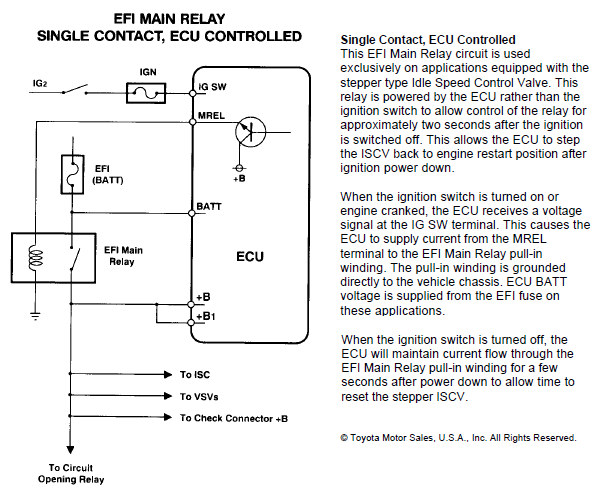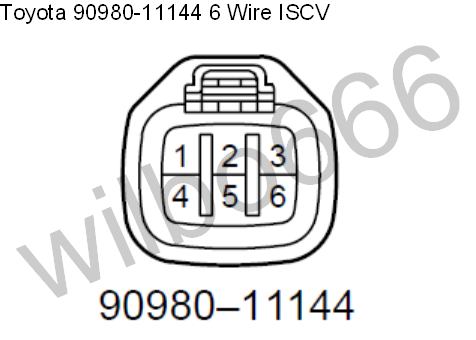Introduction
This page provides information in regards to the function and wiring of Toyota's 6 wire ISCVs (Idle Speed Control Valve).
Correct operation of Toyota 6 wire ISCVs is heavily dependent on the engine ECU output pin 'M-REL' and associated circuit so the function and operation of the engine ECU pin is also detailed on this page .
This guide focuses on the "6 wire" ISCVs as found on 7M, 1JZ, 2JZ and other Toyota engines, however it will apply in some extent to all ISCVs.
If you've found my work helpful and would like to donate a beer! PayPal.Me/wilbo666wiring
ISCV Function
The function of the ISCV (Idle Speed Control Valve) is to allow the engine to maintain the correct idle speed as determined by the engine ECU, regardless of engine temperature, AC state (On/Off), electrical loads, etc.
The ISCV achieves idle control by providing a path for intake air around the throttle, this effectively acts to open the throttle and allow more air in to the engine, leading to raised idle. In fact on engines with Electronic Throttles (e.g. Toyota ETCS-i) there is normally no separate ISCV as this functionality can be incorporated into the Electronic Throttle.
On turbo applications a one way valve is installed so that boost pressure cannot exit the plenum / after the throttle body. The one way valve is usually a small metal disk with a rubber flap acting as the one way valve element.
ISCV Operation
Toyota 6 wire ISCVs use a stepper motor to control a plunger that sets how "open" or "closed" the ISCV is.
The amount of air that bypasses the throttle via the ISCV determines how much the idle is raised by. The more open the ISCV the higher the engine idle.
M-REL / 6 Wire ISCV Wiring
Main EFI relay switched power is supplied to the two centre pins (pin 2 and 5) of Toyota 6 wire ISCVs and the engine ECU grounds the stepper motor coils (connects them to ground) in the correct order to open or close the ISCV as required to raise or lower the engine idle speed.
The power that is connected to the ISCV is via the main EFI relay which is controlled by the engine ECU M-REL output pin. The main EFI relay is controlled by the engine ECU M-REL output pin which the engine ECU keeps energised / powered for a few seconds (~3 seconds) after the engine is shut down / turned off. Keeping the engine ECU M-REL output on, and as a result the main EFI relay on after engine shut down keeps the ISCV powered and allows the engine ECU to fully open the ISCV. The ISCV should NOT be powered by a switched ignition source or relay and doing this will result in incorrect ISCV operation and idle issues.
Upon turning a running engine off the engine ECU and the ISCV (among other items) remain powered for a few seconds allowing the ISCV to be fully opened by the engine ECU. This is done for at least two reasons,
- To 'reset' the ISCV - the engine ECU needs to know what position the ISCV is in to be able to control it correctly. Resetting the ISCV at the end of each engine operation achieves this requirement.
- To enable the engine to start with greater ease - having the ISCV fully open will lead to a high idle upon start up by default.
Note: Delayed turning off of the M-REL engine ECU output and opening of the ISCV only appears to occur if the engine ECU detects that the engine has actually been running.
The below diagrams shows how the system is wired.


In general,
- The engine ECU knows when the ignition is on via the IGN pin on the engine ECU (The engine ECU IGN pin receives +12V when the ignition is in the ON or CRANK positions)
- When the ignition is on (and for ~3 seconds after the ignition has been switched off) the engine ECU turns the engine ECU M-REL output pin on
- When the engine ECU M-REL output pin is on it outputs +12V power to the main EFI relay to turn the main EFI relay on
- When the main EFI relay is on, +12V power is connected to the engine ECU, ISCV, etc to power them
- When the engine is started the engine ECU knows the ISCV is fully open and closes it as required after engine start up to achieve the desired idle speed
- During normal operation the engine ECU continues to open and close the ISCV small amounts to maintain the desired idle speed
- When the ignition / engine is switched off the engine ECU continues to power the main EFI relay via the M-REL engine ECU output. This gives the engine ECU time to fully open the ISCV (resetting it)
- After the ISCV has been fully opened by the engine ECU, the engine ECU turns the M-REL engine ECU output off, which turns the main EFI relay off and disconnects power from the engine ECU, ISCV, etc
Wiring Summary,
- Engine ECU M-REL output pin is used to trigger the "main EFI relay" coil by suppling +12V. Note, the remaining pin of the main EFI relay coil is grounded.
- When energised the main EFI relay switches battery voltage to the ISCV (pins 2 and 5) as well as the engine ECU +B pins
Toyota 6 Wire ISCV Plug Pinout (90980-11144)

| ISCV Pin Number |
Engine ECU Symbol |
Definition |
What |
Why |
How |
| 1 |
ISCV2 |
Idle Speed Control Valve |
This pin is used to open / close the Idle Speed Control Valve (ISCV) to allow more or less air to enter the engine as required to keep the desired engine idle speed |
There are a large number of items that effect idle speed (e.g. engine temperature, electrical load, etc) an Idle Speed Control Valve allows the engine ECU to compensate and attempt to maintain the desired engine idle RPM. |
This pin is connected to Ground inside the ECU as required in a sequenced fashion with the other ISCVx pins to open / close the ISCV as required by the engine ECU. The ISCV has two power pins which should be connected to battery voltage (Main EFI Relay switched). |
| 2 |
+B |
EFI Main Relay Switched Power |
This pin is used to supply switched battery power to the ISCV. |
Used to supply power. |
This pin is connected to battery voltage when the Main EFI Relay is energized to supply power to the ECU. The Main EFI Relay is triggered by the engine ECU pin M-REL pin. |
| 3 |
ISCV4 |
Idle Speed Control Valve |
This pin is used to open / close the Idle Speed Control Valve (ISCV) to allow more or less air to enter the engine as required to keep the desired engine idle speed |
There are a large number of items that effect idle speed (e.g. engine temperature, electrical load, etc) an Idle Speed Control Valve allows the engine ECU to compensate and attempt to maintain the desired engine idle RPM. |
This pin is connected to Ground inside the ECU as required in a sequenced fashion with the other ISCVx pins to open / close the ISCV as required by the engine ECU. The ISCV has two power pins which should be connected to battery voltage (Main EFI Relay switched). |
| 4 |
ISCV1 |
Idle Speed Control Valve |
This pin is used to open / close the Idle Speed Control Valve (ISCV) to allow more or less air to enter the engine as required to keep the desired engine idle speed |
There are a large number of items that effect idle speed (e.g. engine temperature, electrical load, etc) an Idle Speed Control Valve allows the engine ECU to compensate and attempt to maintain the desired engine idle RPM. |
This pin is connected to Ground inside the ECU as required in a sequenced fashion with the other ISCVx pins to open / close the ISCV as required by the engine ECU. The ISCV has two power pins which should be connected to battery voltage (Main EFI Relay switched). |
| 5 |
+B |
EFI Main Relay Switched Power |
This pin is used to supply switched battery power to the ISCV. |
Used to supply power. |
This pin is connected to battery voltage when the Main EFI Relay is energized to supply power to the ECU. The Main EFI Relay is triggered by the engine ECU pin M-REL pin. |
| 6 |
ISCV3 |
Idle Speed Control Valve |
This pin is used to open / close the Idle Speed Control Valve (ISCV) to allow more or less air to enter the engine as required to keep the desired engine idle speed |
There are a large number of items that effect idle speed (e.g. engine temperature, electrical load, etc) an Idle Speed Control Valve allows the engine ECU to compensate and attempt to maintain the desired engine idle RPM. |
This pin is connected to Ground inside the ECU as required in a sequenced fashion with the other ISCVx pins to open / close the ISCV as required by the engine ECU. The ISCV has two power pins which should be connected to battery voltage (Main EFI Relay switched). |
Toyota 6 Wire ISCV Waveforms
The factory or OEM waveform to open the ISCV is detailed in the below image. The sequence is ISCV4, ISCV3, ISCV2, ISCV1 with a half phase overlap.
When the ISCV is not being moved or stepped the engine ECU has none of the ISCVx pins connected to Ground, they are Open Circuit.
Note: In steady state stepping ISCV1 = /ISCV3 and ISCV2 = /ISCV4 ('/' means inverted).
Note: It appears that there are a number of different stepper motor drive waveforms that are employed but the engine ECU, of which the fastest Low to High, High to Low, Low to High time period is approximately 33mSec.

References
Autoshop101 Reference: 25 Engine Controls #2 - ECU/Outputs.pdf file size 495KB
Cygnusx1 MA70 TSRM: http://www.cygnusx1.net/Supra/Library/TSRM/MK3/manual.aspx?S=FI&P=106
Cygnusx1 MA70 TSRM: http://www.cygnusx1.net/Supra/Library/TSRM/MK3/manual.aspx?S=FI&P=107
Views: 
Comments (0)
You don't have permission to comment on this page.